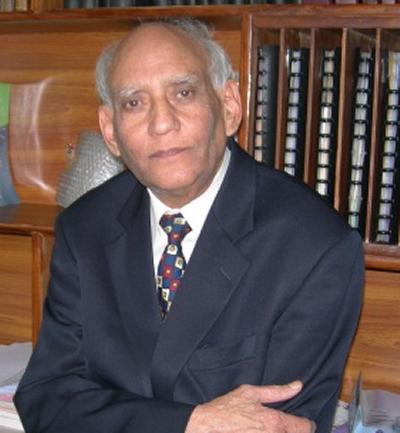References: the order of the references is as cited in 'Research Interests'.
1. Substrate activation in pyridine nucleotide linked reactions: Illustrations from the steroid field.
M. Akhtar, D.C. Wilton, I.A. Watkinson and A.D. Rahimtula.
Proc. R. Soc. Lond. B 180, 167 177 (1972)
2. Some biological transformations involving unsaturated linkages: The importance of charge separation and charge neutralisation in enzyme catalysis.
M. Akhtar and C. Jones.
Tetrahedron Report 34, 1 20 (1978)
3. Mechanism and stereochemistry of enzymic reactions involved in porphyrin biosynthesis.
M. Akhtar, M.M. Abboud, G. Barnard, P. Jordan and Z. Zaman.
Phil. Trans. R. Soc. Lond. B. 273, 117 136 (1976)
4. Mechanistic studies on C 19 demethylation in oestrogen biosynthesis.
M. Akhtar, M.R. Calder, D.L. Corina and J.N. Wright.
Biochem. J. 201, 569 580 (1982)
5. A review of mechanistic studies on aromatase (CY19) and 17α-hydroxylase-17, 20-lyase (CY17)
Muhammad Akhtar, J. Neville Wright, Peter Lee-Robichaud
J. Steroid Biochem. and Mol. Biol. 125: 2-12 (2011).
6. A unified mechanistic view of oxidative reactions catalysed by P-450 and related Fe-containing enzymes.
M. Akhtar and J.N. Wright.
Natural Products Reports, 8, 527-612 (1991).
7. Sequence and interspecies transfer of an aminoglycoside phosphotransferase gene (APH) of Bacillus circulans.
C.J. Herbert, M. Sarwar, S.S. Ner, I.G. Giles and M. Akhtar.
Biochem.J. 233, 383 393 (1986).
8. Studies on vision: The nature of the retinal opsin linkage.
M. Akhtar, P.T. Blosse and P.B. Dewhurst.
Biochem. J. 110, 693 (1969)
9. Structural studies on membrane bound bovine rhodopsin.
E. Mullen and M. Akhtar.
Biochem. J. 211, 45 54 (1983)
10. The incorporation of tritiated retinyl moiety into the active site lysine residue of bacteriorhodopsin.
E. Mullen, M.G. Gore and M. Akhtar.
Biochem. J. 183, 175 178 (1979)
11. Topography of the rhodopsin molecule: Identification of the domain phosphorylated.
G.J. Sale, P. Towner and M. Akhtar.
Biochem. J. 175, 421 430 (1978)
12. Interplay of phosphorylation and dephosphorylation in vision: Protein phosphatases of bovine rod outer segments.
C. Fowles and M. Akhtar.
Biochemistry, 28, 9385 9391 (1989).
13. The phospho-opsin phosphatase from bovine rod outer segments: An insight into the mechanism of stimulation of type-2A protein phosphatase activity by protamine. Alastair J. King, Natasa Andjelkovic, Brian A. Hemmings & Muhammad Akhtar. Eur.J.Biochem., 225, 383-394 (1994).
14. Mechanistic studies on rhodopsin kinase: Light-dependent phosphorylation of C-terminal peptides of rhodopsin.
Neil G. Brown, Charles Fowles, Ram Sharma and Muhammad Akhtar
Eur. J. Biochem. 208, 659-667 (1992).
15. Lysine mutagenesis identifies cationic charges of human CYP17 which interact with cytochrome b5 to promote male sex hormone biosynthesis.
P. Lee-Robichaud, M.E. Akhtar, M. Akhtar
Biochem. J. 342, 309-312 (1999)
16. Mechanism and substrate stereochemistry of 2-amino-3-oxobutyrate CoA ligase: implications for 5-aminolevulinate synthease and related enzymes
Qamar Bashir, Naeem Rashid and Muhammad Akhtar
Chem. Commun. 5065-5067 (2006).
17. Inventory of ‘slow exchanging' hydrogen atoms in human proinsulin and its derivatives: Observations on the mass spectrometric analysis of deuterio-proteins in D2O.
Qurra-tul-Ann Afza Gardner, Hooria Younas, Naeem Rashid, J. Neville Wright, Muhammad Akhtar,
Biochimica Biophysica Acta 1794 1224-1233 (2009).
18. Conformational transmission in proinsulin and its derivatives: A study using H/D exchange.
Hooria Younas, Qurra-tul-Ann Afza Gardner, Naeem Rashid, J. Neville Wright, Muhammad Akhtar
Int. J. of Mass Spectrom. 302 36-43 (2011).
19. Structure and Function of the L-threonine Dehydrogenase (Tk TDH) from the hyperthermophilic archaeon Thermococcus kodakaraensis
A. Bowyer , H. Mikolajek , J.W. Stuart , S.P. Wood, F. Jamil , N. Rashid , M. Akhtar , J.B. Cooper.
Journal of structural Biology 168: 294-304 (2009).
